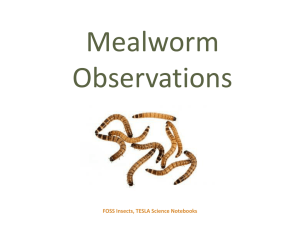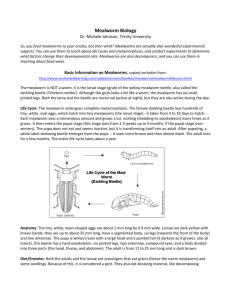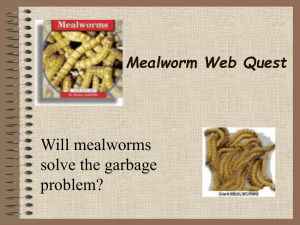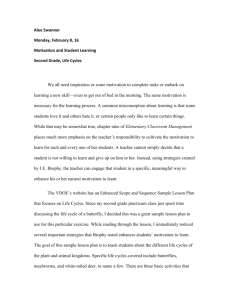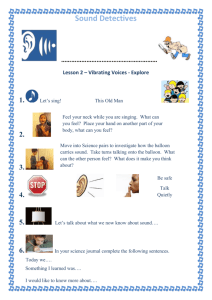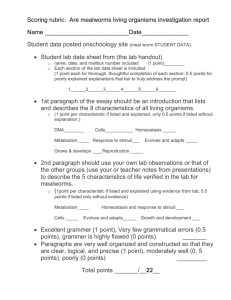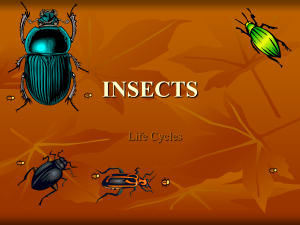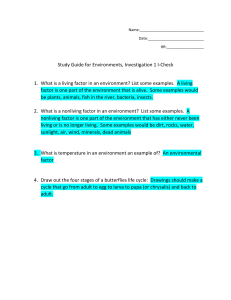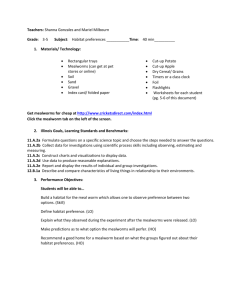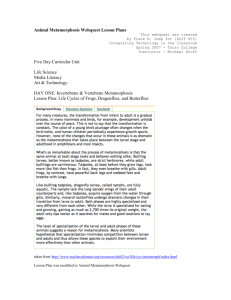Observe the mealworms and answering the following questions
advertisement
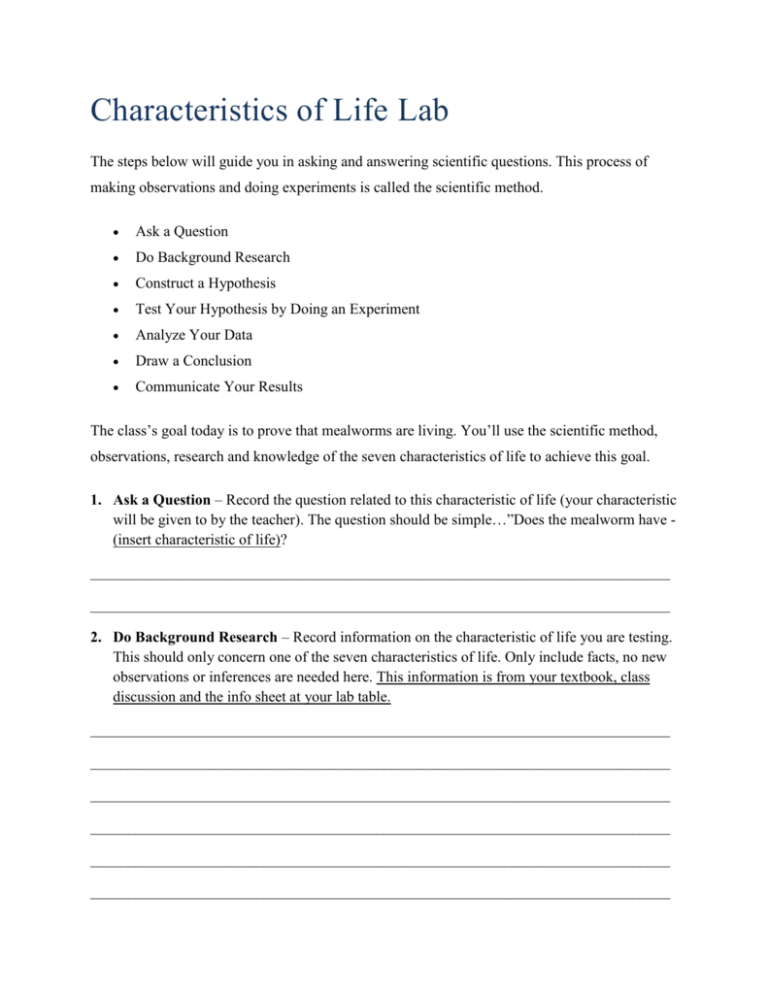
Characteristics of Life Lab The steps below will guide you in asking and answering scientific questions. This process of making observations and doing experiments is called the scientific method. Ask a Question Do Background Research Construct a Hypothesis Test Your Hypothesis by Doing an Experiment Analyze Your Data Draw a Conclusion Communicate Your Results The class’s goal today is to prove that mealworms are living. You’ll use the scientific method, observations, research and knowledge of the seven characteristics of life to achieve this goal. 1. Ask a Question – Record the question related to this characteristic of life (your characteristic will be given to by the teacher). The question should be simple…”Does the mealworm have (insert characteristic of life)? _____________________________________________________________________________ _____________________________________________________________________________ 2. Do Background Research – Record information on the characteristic of life you are testing. This should only concern one of the seven characteristics of life. Only include facts, no new observations or inferences are needed here. This information is from your textbook, class discussion and the info sheet at your lab table. _____________________________________________________________________________ _____________________________________________________________________________ _____________________________________________________________________________ _____________________________________________________________________________ _____________________________________________________________________________ _____________________________________________________________________________ 3. Construct a Hypothesis – “If...then...” statement. _____________________________________________________________________________ _____________________________________________________________________________ 4. Test your hypothesis by following lab procedures at your station. – Only observations are allowed here. Inferences are not appropriate at this time. Record your observations below. _____________________________________________________________________________ _____________________________________________________________________________ _____________________________________________________________________________ _____________________________________________________________________________ _____________________________________________________________________________ 5. Analyze Your Data and Draw a Conclusion – What does your research mean? This is where inferences are finally allowed. Each conclusion should be supported with your observations. Try to connect your background knowledge from Step 2 with your new information from Step 4. This should be more than 2 but less than 5 sentences. _____________________________________________________________________________ _____________________________________________________________________________ _____________________________________________________________________________ _____________________________________________________________________________ _____________________________________________________________________________ 6. Communicate Your Results – Share your results with the rest of the class. Make a brief outline of what you will share. _____________________________________________________________________________ _____________________________________________________________________________ _____________________________________________________________________________ _____________________________________________________________________________ _____________________________________________________________________________ _____________________________________________________________________________ Station 1: Cellular Organization Background Information Single-cell organisms have everything they need to live. Multicellular organisms, have cells that can do only certain things. Living things must be able to organize simple substances into complex ones. Living things organize cells at several levels: Tissue - a group of cells that perform a common function. Organ - a group of tissues that perform a common function. Organ system - a group of organs that perform a common function. Organism - any complete living thing. Research and Experimentation Observe the mealworms and answering the following questions while researching. Does the mealworm have different body parts? Are their body parts made of tissues (how can you tell)? Do their tissues have individual cells (obtain a prepared slide of mealworm tissue)? Station 2: Homeostasis Background Information Homeostasis describes the successful survival of cells inside of an organism and the overall balance of systems within the organism. It is similar to the idea of equilibrium. When discussing the internal workings of an organism, homeostasis describes an environment that supports the survival of cells. Many systems work together to maintain homeostasis inside of living things. Homeostasis is achieved by making sure the temperature, pH (acidity), and oxygen levels (and many other factors) are set just right for your cells to survive. Homeostasis levels are different for each species. A good example of system regulation of your body can be found in the regulation of body temperatures. You are a warm blooded organism, which means you regulate your own body temperature internally. Some other organisms, like mealworms are cold blooded and their body temperature depends on the environment. Research and Experimentation Observe the mealworms and answer the following questions while researching. Do the mealworms act differently in different temperature environments? What types of behaviors can you observe in the cold and the warm environments? Station 3: Metabolism Background Information Metabolism is such a big word to explain a simple idea. We all need energy to survive. Whether we are plants, animals, or bacteria, we all need energy. Energy doesn't just float around in a form we can use to survive. Living things need to obtain energy and find a way to utilize it. For example, animals eat food and break it down (digestion). Plants make their own food through photosynthesis and utilize the sugars for energy and growth. These processes of obtaining, converting it into usable form, and using it for life processes is called metabolism. Simply put, metabolism is the total of all the chemical reactions an organism needs to survive. Research and Experimentation Observe the mealworms and answering the following questions while researching. Do the mealworms eat? How active are the mealworms? Describe their behavior. Do the mealworms create waste products? Station 4: Grow and Develop Research and Experimentation Observe the mealworms and answering the following questions while researching. Are there mealworms of different sizes? Do the mealworms shed their skin? Measure and record the length of five different mealworms chosen at random. Station 5: Adapt & Evolve Taken as a group, living things evolve. Mealworm Classification Scientific classification: Kingdom: Animalia Phylum: Arthropoda Class: Insecta Order: Coleoptera Family: Tenebrionidae Genus: Tenebrio Species: molitor Meaning: -are multicellular eukaryotes -have jointed limbs and exoskeletons -3 body segments, 3 pair of jointed legs -beetles (sheathed wing) -darkling beetles -means ‘lover of darkness’ -hardly, with difficulty Binomial name: Tenebrio molitor The mealworm is native to Eurasia and evolved from earlier beetle ancestors. Like many ground beetles, it has many things in common; in terms of body shape, appendage structures, and behaviors such as how they feed and a preference for living in dark areas (some are even nocturnal). In its adult stage, these mealworm beetles do not often come into contact with other living organisms. These beetles then display a quite interesting behavior. If they feel threatened they turn upside down on their heads and then spray chemicals from their rear scent gland towards the danger. Being native to Eurasia, the mealworm has evolved naturally in a temperate climate, where winters are characterized by cold temperatures. These mealworms are cold blooded, yet they can survive over the cold winter due to the fact that they produce anti-freeze proteins, that prevent their body tissues from completely freezing. In fact these proteins are so effective, that larvae can survive to -12 C temperatures. The yellow mealworm beetle is similar to the fire colored beetle, and by studying and comparing these anti-freeze proteins scientists are learning about when these beetles last had a common ancestor. 1) What are two adaptations that the yellow mealworm beetle has? How do they help them survive? 2) The whirligig beetle is more distantly related to the yellow mealworm than the fire colored beetle. Predict: Which anti-freeze proteins would be more similar to the yellow mealworm’s proteins, the whirligig or the fire colored? Why? Name: _______________________________ Lab Analysis and Conclusion Question Write a short essay (at least 2 paragraphs) explaining why the mealworm should be considered a living thing. Include all 5 characteristics studied lab for your essay. It is expected that you include specific evidence and observations from the lab and from the information given to you from other groups to support your response. __________________________________________________________________ __________________________________________________________________ __________________________________________________________________ __________________________________________________________________ __________________________________________________________________ __________________________________________________________________ __________________________________________________________________ __________________________________________________________________ __________________________________________________________________ __________________________________________________________________ __________________________________________________________________ __________________________________________________________________ __________________________________________________________________ __________________________________________________________________ __________________________________________________________________ __________________________________________________________________ __________________________________________________________________ __________________________________________________________________ __________________________________________________________________ __________________________________________________________________ __________________________________________________________________ __________________________________________________________________ __________________________________________________________________ __________________________________________________________________ __________________________________________________________________ __________________________________________________________________ __________________________________________________________________ __________________________________________________________________ __________________________________________________________________ __________________________________________________________________ __________________________________________________________________ __________________________________________________________________ __________________________________________________________________ __________________________________________________________________ __________________________________________________________________ __________________________________________________________________ __________________________________________________________________ __________________________________________________________________ __________________________________________________________________ __________________________________________________________________ __________________________________________________________________ __________________________________________________________________ __________________________________________________________________ __________________________________________________________________ __________________________________________________________________ __________________________________________________________________ __________________________________________________________________ __________________________________________________________________ __________________________________________________________________ __________________________________________________________________ __________________________________________________________________ __________________________________________________________________ __________________________________________________________________ __________________________________________________________________ __________________________________________________________________ __________________________________________________________________ __________________________________________________________________
